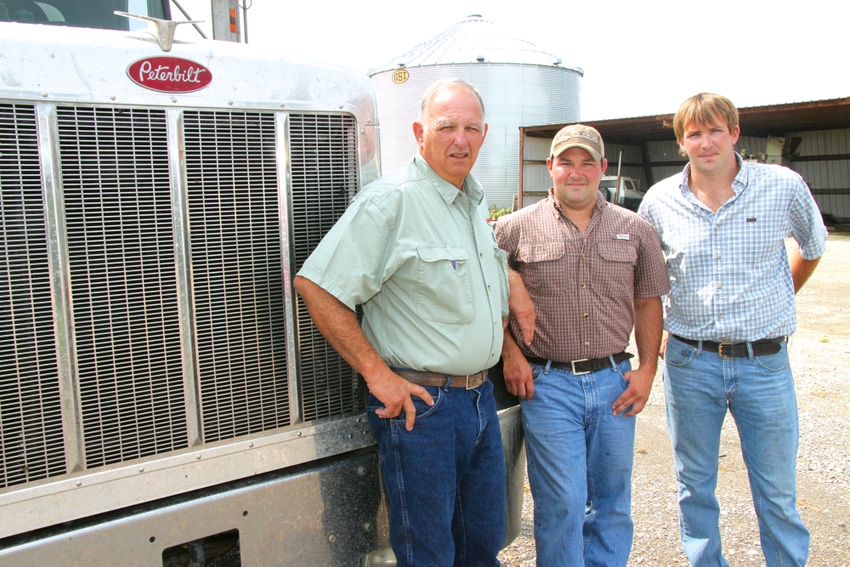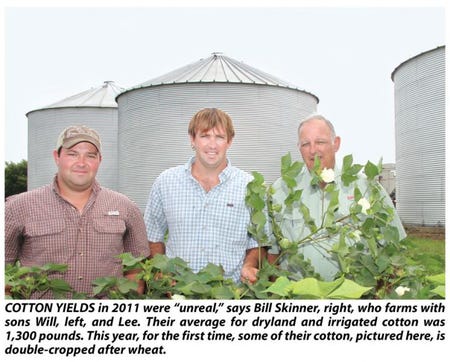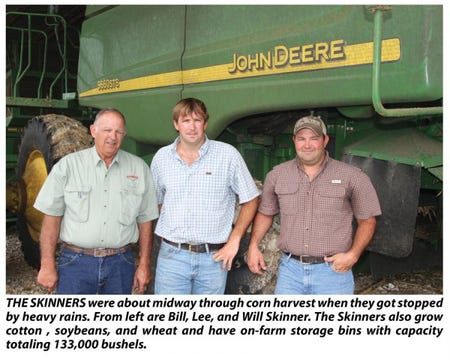
“My father and I used to have land running all the way to the nearby Alabama state line,” says Bill Skinner, who farms with sons Will and Lee near Macon, Miss. “We were farming 4,200 acres, but we were just spread too thin. Now, my sons and I farm 2,600 acres and we're making as much or more yield on fewer acres, thanks to irrigation, improved varieties, and more efficient equipment and technology.” Skinner and his sons operate about 15 farms.

It’s Saturday morning, mid-August, and Bill Skinner and sons Will and Lee still have about half their corn in the field waiting to be harvested — but they’ve had two mornings straight of frog-strangling rainstorms on their farms near Macon, Miss., and radar’s showing another big one over in Arkansas, headed their way.
“These prairie clay soils stay wet,” Bill says, “but if we don’t get any more rain, we’ll be back in the fields Tuesday. We want to get the corn out, even if we have to run in the mud.”
This is “one of the best years we’ve had for dryland corn,” Lee says. “It has been running 120 to 180 bushels, depending on the field and the amount of rainfall. We expect the irrigated corn will be on the high end of that range.”
Last year, Will notes, “When we went from harvesting our dryland to irrigated corn, there was a 100 bushel yield difference. With that kind of result, irrigation for corn is a no-brainer.”
Bill, Will, and Lee each have separate farms, but they share equipment and all work together in planting, harvesting, and other operations.
“Together, we farm about 2,600 acres,” Bill says. “About one-third of that is irrigated with center pivots that are fed from ponds that were in catfish. With crop prices as they are, and catfish prices declining, we figured the water was more valuable than the fish. We have about 75 acres in ponds, and we’re currently running five center pivots from the ponds; four are all electric Zimmatics. The first system we installed, a T-L, is being run from an old well. The systems water anywhere from 55 acres to 230 acres.”
They’re in the process of connecting three ponds to make a 40-acre lake, which will allow them to add another pivot and water an additional 360 acres. Pipes run from the ponds to the center pivots; the longest pipe runs are about 5,200 feet.
This year, they have 905 acres of corn, 800 acres of cotton, and 800 acres of soybeans. They had 155 acres of wheat, 100 acres of which is double-cropped to soybeans, and 55 acres to cotton.
“We averaged 55-60 bushels on the wheat, and were very pleased with that yield,” Lee says. “In the fall, we broadcast the wheat, then hip up into rows. After the wheat comes off, we already have beds in place, and we plant soybeans directly into the stubble with our twin-row Monosem and CrustBuster planters.”
For cotton this year, the Skinners have planted all Deltapine varieties: DP 1048 B2RF, DP 1133 B2RF, and DP 1137 B2RF.
Noxubee County, where they farm, had some of the highest cotton yields in Mississippi in 2011. Says Bill, “I’ve been growing cotton most of my farming lifetime, and I could never have dreamed I’d ever see the kind of yields we got last year. It was unreal — plants loaded from top to bottom with beautiful, snow white cotton. The DP 1048 B2RF, which was all dryland, performed really well. Our average for dryland and irrigated was 1,300 pounds, which was outstanding.”
The Skinners use poultry litter as their main fertilizer, applying 2 tons per acre. “We soil test and add potash, mixed fertilizer, and lime as needed,” Will says. “Corn is sidedressed with nitrogen.
“Most of our land is minimum till. After we harvest corn, we’ll spread the poultry litter, disk, and rehip. If we’ve rutted up a field, we’ll go in and work it up.
Moving to RTK systems
“We’re in the process of swapping everything to 12-row equipment and RTK guidance, so we may have to rework some of our land to get all the beds straight. Next year, when we go to RTK, we also plan to start yield mapping.”
This is their third year to use precision planting technology, he says. “The equipment is expensive, but it’s a real money-saver. It allows us to get exact plant population and spacing, resulting in much more uniform stands and better yields.”
The Skinners’ herbicide program includes Roundup and Leadoff for burndown on corn ground, Roundup and Valor on cotton, and Roundup and atrazine on corn.
“This year, we’ve used some Staple and Envoke for morningglory, our biggest weed problem in cotton, and for sicklepod,” says Will, who handles the spraying. “For soybeans, we’ve used Roundup and Sequence for grass and sicklepod, with good results.”
They’ve had no glyphosate resistant pigweeds thus far, and says Bill, “If we see any pigweeds in the field, we get them out immediately.”
It has been a pretty light year for insects, Will says. “We’ve got some loopers now that we’re spraying. Normally, we’d be treating for stink bugs this time of year, but they’ve not been a problem. We’ve used Dimilin for worms and also some Baythroid and Intrepid. We’ve had almost no insects in our corn. We’ve sprayed for plant bugs in cotton.” Rounding out their chemical lineup was Quadris fungicide on wheat and soybeans.
“Prior to the eradication program, boll weevils were always a problem for us, although we never had any out-of-control situations,” Bill says. “Since eradication though, we’ve not had to worry about that pest any more.
“In 1995, worms just ate us up in cotton — we couldn’t kill them with anything. But Bt technology has pretty much taken care of the worm problem.”
The Skinners rotate cotton, corn, and soybeans, and says Will, “Rotation is one of the best things corn has allowed us to do. When we went from continuous cotton to rotation with corn, it made a significant difference in cotton yield.”
Their winter wheat is usually followed by soybeans, but this year, Lee says, “We’re trying some cotton behind wheat. With the abnormally warm spring we had, the wheat came off two or three weeks early, and we planted cotton behind it May 20. At this point in the season, it’s looking good, with an excellent boll load.”
He says they had also wanted to try some twin-row cotton this year, “But everyone told us it would be much harder to pick, so we didn’t do it.”
In 1995, Bill says, they bought a cotton gin just across the Alabama line and ran it for 10 years. “But as cotton acres declined, and labor got harder to get, we shut it down.
“A number of cotton growers in this area have been trying to get a gin in Noxubee County for years, and finally this year things came together. We’re stockholders in the $6.5 million state of the art Bogue Chitto Gin that’s currently under construction east of Brooksville and is expected to be in operation for this ginning season.”
Although industry forecasts are for a continued decline in cotton acres in 2013, Lee says, “Price will be a factor in determining what we do, but we’ll probably continue with about the same acres. We will definitely keep a 50-50 corn-cotton rotation on our irrigated land.”
This year’s soybean roster, all Groups 5.3 to 5.9, include Terrall 59R16, Delta King 533, Progeny 5711, and Pioneer 95Y70.
“Our average is in the 45 bushel range, counting wheat beans,” Lee says. “On our prairie clay soils, beans don’t respond as well to irrigation as cotton and corn, so most of our beans are dryland.”
Twin-row soybeans
They plant on beds, Will notes. “If we plant flat and get a big rain on these soils, the seed tend to rot and it’s hard to get a stand. If we plant on a bed, there’s less replanting.
“All our soybeans are twin-row, and corn is about 50/50 twin-row. We were one of the first to use the twin-row system here and it has worked well for us. The beans shade the middles much more quickly — it used to take single row beans all summer to shade middles — and we have much less weed pressure. We’ve also seen a steady improvement in yield. Once corn starts drying down, morningglories start coming through, but they aren’t as much a problem with twin rows.”
Corn varieties this year include Dekalb 6697 on irrigated land; Armor 1545 PRO, “a good dryland variety”; Pioneer 33N55, a non-Bt refuge variety; Golden Acres 27V01; and Dekalb 6427.
The Skinners have 133,000 bushels of on-farm storage. “We’ve been adding bins all along, and we’re in the process of reworking some old bins that date back to the 1960s,” Lee says.
“We handle marketing ourselves. All our corn is sold to poultry operations and brokers, mostly within a 30–60 mile radius. We sell our beans through Cargill at Guntersville, Ala., and our cotton through Allenberg Cotton.”
Their equipment lineup includes three John Deere 9965 pickers, a 9660 Deere combine, a Caterpillar 45 tracked tractor, a recently acquired Deere 8245R with RTK, two Deere 8400s, a 7220, and a 4020.
“We’ve been buying good used equipment to help hold the line on costs and avoid debt.” Bill says. “My father and I worked our way out from under some debt problems during agriculture’s ‘restructuring’ in the l980s, and we just don’t like to take on a lot of debt.”
The Skinners own about 75 percent of their land, and most of the rest is rented from family members, except for 200 acres they began renting this year near Shuqualak, Miss.
“Dad and I used to have land running all the way to the nearby Alabama state line,” Bill says. “We were farming 4,200 acres, but we were just spread too thin. Now, the boys and I are making as much or more yield on fewer acres, thanks to irrigation, improved varieties, and more efficient equipment and technology.”
They operate about 15 farms between them, and except for the one at Shuqualak, all are within a few miles’ radius.
If additional land became available at reasonable prices, Lee says, “We’d consider some expansion, but there’s not much land changing hands here these days.”
Rather than spending money on getting bigger, Will says, “We’re trying to concentrate on making improvements that will allow us to further boost yields on land we already have. We can do that by adding more irrigation, utilization of RTK technology, and other management practices.”
Smart phones, the Skinners say, are among the most useful devices they have.
“They help us save money and make money,” says Will. “With our Apple iPhones, we can follow markets, watch weather systems to time field operations, we can control some of our center pivots with them, and we have soil maps on them. New ag apps are continually being developed for these phones.”
Fifth generation farmers
Will and Lee are the fifth generation to farm here. The first Skinner came to the area from Virginia in 1815 and grew cotton and raised some cows.
Bill’s father, the late W. E. Skinner, Jr., continued the farming operation after returning from military service (he’d fibbed about his age and enlisted at 17).
“The farm was in pretty rough shape here after Dad came back,” Bill says. “His father was in poor health and hadn’t been able to keep up the place. Dad ran cows for years, and when I came back from school in 1973, he and I started breaking up pastures and putting in row crops. We had about 900 acres, and as people got out of farming, we gradually added to our holdings.
“Will began farming full-time with me in 2002, after finishing diesel school. Dad died in 2008 and that year Lee started farming, after finishing at Mississippi State University in real estate and mortgage finance.”
In addition to the farming operations, Bill and his wife, Tracy, have a trucking business, which they started in 1977. “We haul grain and fertilizer the year round,” Bill says. “We own three trucks and have owner/operator leases for others. Tracy does all the bookwork, and she also has a clothing store.”
Lee’s wife, Chelsie, keeps books for his operation and is also near completing a master’s degree in nursing and will become a family nurse practitioner in December. “We do all the repairs and maintenance on our equipment. We don’t lack for things to keep us busy,” Bill says.
The Skinners are particularly complimentary of their area suppliers, crop scouts, and Farm Services Agency personnel, and local banks.
“Our long-time cotton scouts are David and Kyle Skinner (no kin) at Starkville, Miss., and we value their advice,” says Bill. “We buy our chemicals through Jimmy Sanders and CPS (Crop Production Services); both are a pleasure to work with.
“The FSA staff has been really helpful over the years with operating loans and financing, particularly when Will and Lee came back to start farming. As expensive as land and equipment are nowadays, young folks just can’t get into farming without help. And the Bank First Financial Services and Citizens National Bank folks have been great to work with us.
“My father and my grandfather helped me when I started farming, and I’ve helped my sons get established. But these financial institutions have been a big help in making it possible for Will and Lee to become farmers in their own right.”
About the Author(s)
You May Also Like



